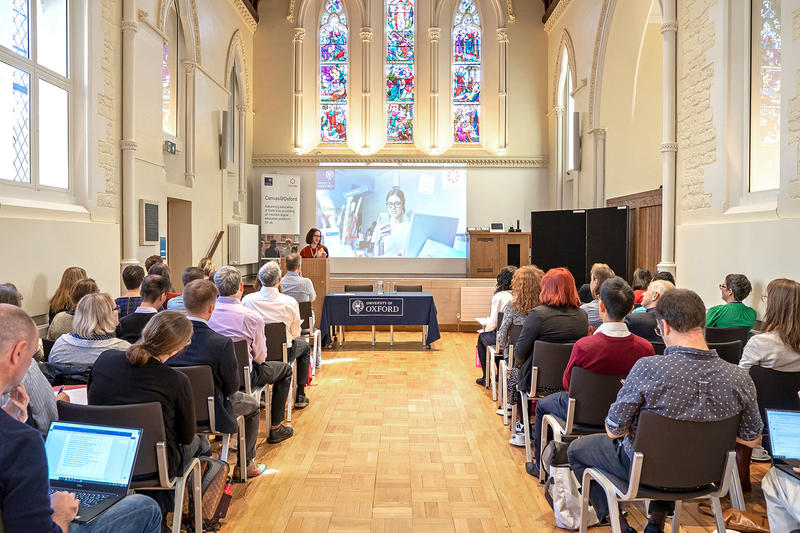Our programme to bring in a new VLE for the University is more than a technology replacement programme.
Canvas@Oxford is an opportunity to open up conversations around digital education and the role of the VLE at Oxford. It also provides an opportunity to break down some of the barriers that exist around using digital tools and spaces in teaching and learning. As such it is vital that we have a vision statement which reflects our education-first approach, how our new VLE, Canvas by Instructure, will support this, and who will benefit from this change.

Kate Lindsay, former head of the Technology Enhanced Learning team, presenting the Canvas vision.
Photo by Michael P. Sannwald.
This is the vision statement:
Advancing education at Oxford by providing an intuitive digital platform for all.
As a team of learning technology experts we need to be able to talk about this vision in our discussions with academic staff and course teams, so that we can paint a picture of the job that we have hired Instructure to do; the student experience we are aiming for; and importantly address the whys around why we are changing.
Let's break down the vision statement into its three core parts.
1. Advancing education at Oxford...
Oxford provides a world-class education, and regularly tops the global HE league tables.
This educational model, known fondly as the Oxford Experience, is built ona set of core educational principles:
- Providing intellectually stimulating conversations (through tutorials);
- small scholarly communities (through the colleges);
- research-led teaching;
- and a flexible, personalised curriculum that enables students to go beyond their disciplines and decide the shape of their own course of study.
To advance these principles is not to replace them.
The mechanisms through which they are enacted - the tutorial system, the colleges, are unique and for many highly effective, but they are not the only ways in which these principles can be realised. By being more digitally engaged and pedagogically reflective we can explore how Canvas can support Oxford's ethos.
At a basic level huge benefits can be realised - through time-saving streaming resources, and providing the digital integrations that students expect in the 21st century. This supports and enriches current practice.
At an advanced level digital spaces can provide enhanced and alternative opportunities to learn and collaborate in learning. The digital classroom is a global classroom, and provides opportunities for cross-disciplinary, cross-cultural, and cross-geographical learning.
There are also opportunities for individual academics and course teams to plug-in digital tools specific to their course learning objectives, and design rich online learning activities. Rather than simply providing an 'online version' of a subject, we can reshape it. To do this we need staff and students with digital literacies, who can be effective tutors and learners in an online context. As such Canvas@Oxford is not just about the tool itself, it is also about supporting and evolving the development of lifelong digital capabilities.
2. ...by providing an intuitive digital platform...
Aesthetics matter.
Usability is key to technology uptake.
Interface design can shape the learning experience.
In our review of our existing VLE one of the key findings was that staff and students found its usability, navigation and interface cumbersome and clunky, and as such we ranked these features very highly in our tender evaluations of VLE platforms. By removing usability barriers we are enabling students to engage more with content and activities, and educators to engage more with learning design.
Furthermore the view of what an intuitive digital platform is moves on at a rapid pace. A VLE does not only exist on the desktop computer or laptop, they need to be rendered seamlessly across mobile devices and operating systems. Regular, frequent interface updates are easily provided through a cloud-based VLE, and dedicated mobile applications can enable access to learning and teaching anytime, anywhere.
3. ...for all.
Our core learning platform will provide a digital space that is available to all our students, all who teach, and all who support teaching and learning.
Through simply making learning resources available online we can offer greater flexibility and accessibility to learning. This is powerful. The digital allows us to meet more people's needs than ever before. We are currently looking at accessibility plugins to enable us to unlock the full potential of the VLE to support those with disabilities, those with specific learning difficulties, and those with access requirements.
There are also a huge cohort of staff and students who benefit from online accessible provision but who may not ask for help, such as staff and students with mental health problems, those with carer responsibilities, or those with less flexibility because of other academic commitments or the need to work as well as study.
Personally, for me, the exclamation that it is 'for all' that is the most powerful part of this statement.
The University's 2018-2023 draft strategic plan sets out a desire to "set ambitious targets" to "reduce by 2023 gaps in attainment by gender, ethnic origin and socio-economic background". It also wants to "substantially increase" the number of undergraduate places offered to students from groups who are currently under-represented, and "accommodate growth in student numbers" overall. But yet it costs almost double to fund an undergraduate's place at Oxford than what they pay in fees, largely due to the face-time intensive tutorial model and collegiate setting.
It is time to explore how the Oxford Experience can exist at a consistent high calibre across physical and virtual spaces, support both retaining and refreshing the University's rich academic environment - not only as a means to develop personal and transferable skills to succeed in a global workplace, but to reach out wider, be more inclusive, and continue to advance excellence in teaching and learning.